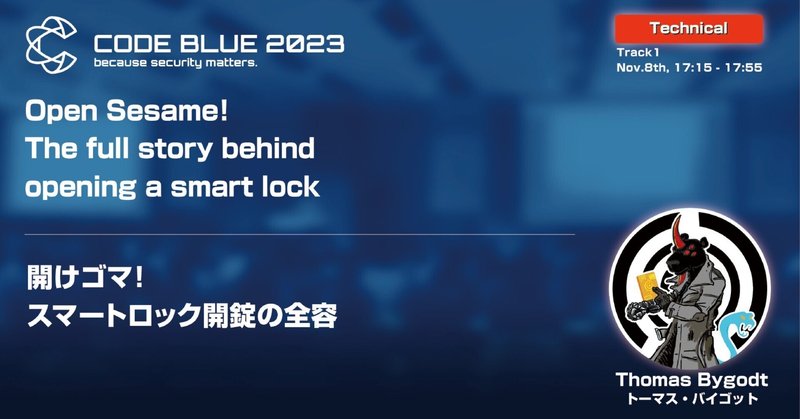
【CODE BLUE 2023】トーマス・バイゴット / Thomas Bygodt
●Abstract
開けゴマ! スマートロック開錠の全容 [ja]
Open Sesame! The full story behind opening a smart lock [en]
今回は、テクニカルのカテゴリから「開けゴマ! スマートロック開錠の全容」のトーマス・バイゴット氏に話を伺いました。バイゴット氏はフランスを中心にグローバルに展開するOrangeCybersecurityのペネトレーションテスターを務めています。講演のテーマは、スマートロックのハッキングです。
ターゲットとしたのは、PINコード・NFC・モバイルアプリに対応した製品です。ハッキングは、ハードウェアの分析に始まり、ロックとモバイル端末間の通信の解析、そしてファームウェアのリバースエンジニアリングへと続きます。この過程でBLE(Bluetooth Low Energy)接続に脆弱性を発見したそうです。さらに影響は、同じ開発キット(SDK)を利用している他の製品にも及ぶといいます。
講演では、研究を始めた2021年から今回の発表にいたる約2年間の活動が時系列で紹介されます。バイゴット氏は、これまでに同じテーマの講演を他のカンファレンスでも行っていますが、今回は、CODE BLUE向けにアップデートした情報が提供されるといいます。
●Bio
トーマス・バイゴット[ja]
Thomas Bygodt [en]
ーーー
●Interview
[ja]インタビュー
Q1. 今回、カンファレンスで発表する研究を始めたきっかけを教えてください。
A1. バイク(自転車)用のスマートロックを監査した時にBluetoothの接続をハックしました。これがきっかけとなり、ハードウェアハッキングをさらに深く探求したくなったのです。消費者向けのスマートロックは、特に現在の開発を考慮すると、次の論理的なステップに良いと思えました。そこで、インターネットで人気のあるモデルをランダムに選びました。最終的な結果は、私の初期の期待をはるかに超えたものでした。
Q2. 研究の過程でどのような点で苦労しましたか?
A2. ベアメタルARMファームウェアのリバースエンジニアリングには非常に多くの時間がかかります。特に、数千の関数と数十の変数がある場合、関数の目的を理解するのは簡単ではありません。例えば、変数が何を表しているのか分からなかったため、驚くようなことを行う関数の実際の脆弱性を見つけるのに長い時間がかかりました。研究の過程での結果の開示は、ロック製造業者との間で複雑でした。すべてのレポートを送信したにもかかわらず、 coherentな回答を得るのに1年以上かかりました。
Q3. CODEBLUEの参加者、参加を検討している人に向けてメッセージをお願いします。
A3. ハードウェアハッキングの世界は、多くの人々、研究者や製造業者(その中にはハッキングが難しいと考えている人もいる)にとって、黒魔術のように思えます。しかし、接続されている、または「スマート」なオブジェクトがたくさんあり、そのすべてがTeslaやSonosのように進んでいるわけではありません。ほとんどの場合、電子機器は基本的で、ファームウェアは限定的です。ハッキングするだけの時間がかかります。最初の印象が良好であっても、ベストプラクティスが守られていないため、致命的な「アプリケーションレベル」の脆弱性を見つけることが一般的です。これが私が話したい内容であり、2021年6月から最新の脆弱性までの私の研究を振り返るものです。これはCODE BLUEで初めて公開されるものです。
ーーー
[en]Interview
Q1. How did you initiate your journey into the topic that you are presenting?
A1. After auditing a smart bike lock, during which I hacked the Bluetooth connectivity, I wanted to go further into hardware hacking.
Consumer oriented smartlocks seemed like the logical next step, especially considering their current development. So I chose a random model that was popular on the Internet. The final results exceeded all my initial expectations.
Q2 What were some challenges you faced during this research?
A2. Reverse engineering a bare metal ARM firmware takes an enormous amount of time. It's not easy to figure out the purpose of a function, especially when you have thousands of them with dozens of variables. For example, it took me a long time to find the real vulnerability in a function that did some suprising things, because I didn't know what the variables represented.
Disclosing the results throughout my research was complicated with the lock manufacturer. It took over a year to get a coherent answer despite all the reports sent.
Q3 What message would you like to convey to those considering attending this talk?
A3. The world of hardware hacking sounds like black magic to many people, both to researchers and to the manufacturers (some of whom think it is too hard to get hacked). But there are so many connected or 'smart' objects that not all of them are as advanced as Tesla or Sonos. Hacking most of them just takes time, because the electronics are basic and the firmware is limited. It's common to find critical "application-level" vulnerabilities because best practices aren't followed, even if everything looks good at first glance.
This is what I'd like to share in my talk, which looks back on all my research from June 2021 to the latest vulnerabilities that will be disclosed for the first time at CODE BLUE.
